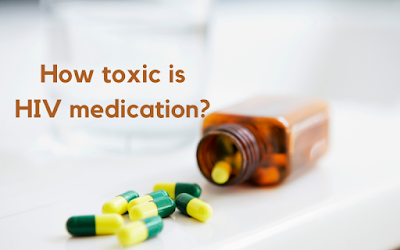Antiretroviral therapy (ART) has transformed the Human Immunodeficiency Virus (HIV) infection into a manageable chronic disease. There is a long
list of HIV medications that have the potential to cause short-term and long-term adverse effects. The spectrum of potential ARV (antiretroviral) drug toxicity is broad, including renal toxicity, mitochondrial and metabolic effects, gastrointestinal symptoms, cardiovascular effects, hypersensitivity, skin reactions, insomnia, or other neuropsychiatric manifestations, and many other complications. Furthermore, as life expectancy for individuals with HIV has increased, the long-term safety of antiretroviral therapy has garnered increasing attention. On the other hand, newer antiretroviral medications have improved as well as enhanced safety profiles compared with the older antiretroviral medications, and this is reflected in the recommendations issued in the Adult and Adolescent ARV Guidelines. If you're in ambivalence in order to know
how to control HIV infection then if you're living with HIV you should have an understanding of the basic toxicity profile of ARV drugs (antiretroviral). Apart from this, you should keep in mind that the potential side effects of most ARV medications are less toxic than the effects of untreated HIV.
The illustration of groupwise probable drug toxicity is as follows:
Nucleoside Reverse Transcriptase Inhibitors:
The nucleoside reverse transcriptase inhibitors (NRTIs) have several notable class-wide mitochondrial and metabolic effects, though these adverse effects rarely occur with the newer NRTI agents. Any potential impact of the NRTIs on human mitochondria is important, since mitochondria play an essential role in producing energy for the cell in the form of adenosine triphosphate. Mitochondrial toxicity caused by NRTIs induces a wide range of adverse effects, such as lactic acidosis, hepatic steatosis, myopathy, cardiomyopathy, peripheral neuropathy, pancreatitis, and possibly lipodystrophy syndrome. Chronic use of older NRTIs, such as didanosine, stavudine, and zidovudine, can inhibit gamma-DNA polymerase-gamma, the key enzyme responsible for mitochondrial DNA replication; this inhibition can decrease cellular oxidative phosphorylation, increase intracellular lipids, and cause accumulation of lactic acid. The probability of neuropathy and lipoatrophy generally appears with the long-term use of these older NRTIs. These complications only partially reverse, or do not reverse at all, with discontinuation of the offending medication. Such adverse effects are extremely rare with modern NRTIs, such as tenofovir alafenamide, tenofovir DF, abacavir, lamivudine, and emtricitabine. Some other terms may occur as toxicity, which are as follows:
- Hyperlactatemia and Lactic Acidosis
- Peripheral Neuropathy
- Hyperlipidemia
- Lipoatrophy
- Hypersensitivity Reaction
- Cardiovascular Risk
- Nephrotoxicity
- Risk Factors for Nephrotoxicity
- Bone Marrow Suppression
- Myopathy
- Proteinuria
Non-Nucleoside Reverse Transcriptase Inhibitors:
There are six non-nucleoside reverse transcriptase inhibitors (NNRTIs) that have been FDA approved for use: doravirine, efavirenz, etravirine,
nevirapine, and rilpivirine. Some toxic reactions with this group of drugs are as follows:
- Cardiac QTc Interval Prolongation
- Dyslipidemia
- Hepatotoxicity
- Neuropsychiatric
- Rash
- Teratogenicity
- Hypersensitivity Reaction
- Elevated Serum Creatinine
- Neuropsychiatric
Integrase Strand Transfer Inhibitors:
The (INSTIs) generally are well tolerated and drug interactions are minimal. Based on the clinical trials, most frequently reported adverse reactions were headache, nausea, diarrhea, insomnia, and fatigue, but generally were not significant enough to warrant stopping therapy. Behalf of some studies that have specified the integrase strand transfer inhibitors, mainly dolutegravir, lead to greater weight gain than other classes of antiretrovirals, but the mechanism and clinical significance are unclear. Rare cases of INSTIs mood changes or new onset of psychiatric disorders have been observed with INSTIs. A few more toxic effects of INSTIs are elaborated as follows:
- Potential Neural Tube Defects
- Elevated Serum Creatinine
- Insomnia
- Myopathy and Elevated Creatine Phosphokinase
- Elevated Creatine Kinase
- Proximal Myopathy
- Stevens-Johnson Syndrome/Toxic Epidermal Necrolysis.
Protease Inhibitors:
There are currently 10 FDA-approved HIV protease inhibitors (PIs), but in the Adult and Adolescent ARV Guidelines, none are designated in the category of Recommended Initial Regimens for Most People with HIV. PIs may be responsible for some other toxic reaction, which are given as:
- Gastrointestinal Adverse Effects
- Cardiovascular Risk
- Cardiac Conduction Abnormalities
- Bleeding Risk in Persons with Hemophilia
- Lipo-accumulation
- Hyperbilirubinemia
- Nephrolithiasis
- Cholelithiasis
- Hyperlipidemia
- Diarrhea
- Alcohol in Liquid Formulation
Entry Inhibitors:
- Rash
- Hepatotoxicity
- Impact of Host Immune Function
Pharmacologic Boosters:
Ritonavir and cobicistat are pharmacokinetic enhancers to boost the concentration of other antiretroviral agents used in
HIV treatment. Both medications work by interacting with the hepatic metabolism of antiretroviral drugs through the cytochrome P450 (CYP450) system; however, because of this mechanism of action, they can also affect the levels of other medications that are coadministered, leading to clinically significant (and occasionally unpredictable) drug interactions and potential adverse effects. This class of medications associated with several toxic reactions, which are as follows:
- Abdominal pain
- Diarrhea
- Nausea
- Vomiting
- Gastrointestinal Symptoms
NOTE: Numerous existing antiviral HIV/AIDS medications, were being researched as COVID‑19 treatments, with some moved into clinical trials.
And according to clinical studies some
HIV medications are also helpful in COVID 19.

I was diagnosed as HEPATITIS B carrier in 2013 with fibrosis of the
ReplyDeleteliver already present. I started on antiviral medications which
reduced the viral load initially. After a couple of years the virus
became resistant. I started on HEPATITIS B Herbal treatment from
ULTIMATE LIFE CLINIC (www.ultimatelifeclinic.com) in March, 2020. Their
treatment totally reversed the virus. I did another blood test after
the 6 months long treatment and tested negative to the virus. Amazing
treatment! This treatment is a breakthrough for all HBV carriers.